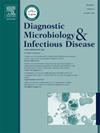Clinical indicators associated with tuberculous meningitis using multiple correspondence analysis
IF 2.1
4区 医学
Q3 INFECTIOUS DISEASES
Diagnostic microbiology and infectious disease
Pub Date : 2025-06-03
DOI:10.1016/j.diagmicrobio.2025.116932
引用次数: 0
Abstract
Objectives
Tuberculous meningitis (TBM), the most severe extrapulmonary manifestation of Mycobacterium tuberculosis (Mtb) infection, contributes to 5–10 % of global tuberculosis-related mortality. This study aimed to delineate clinical indicators predictive of microbiologically confirmed TBM to facilitate early diagnosis in resource-limited settings.
Methods
A retrospective cohort analysis was conducted on 146 TBM cases admitted to Shenzhen Third People's Hospital (2018-2020), undergoing cerebrospinal fluid (CSF) culture and Xpert. Epidemiologic profiles and clinical outcomes were systematically characterized. Multiple correspondence analysis (MCA) adjusted for potential confounders was employed to identify clinical indicators associated with microbiologically confirmed TBM.
Results
Among 146 patients with defined or probable TBM, 80 cases were detected for Mtb in CSF, with undetected in 66 cases. The increase in CSF white cell count was more significant than that in blood. Serum sodium, serum chloride (Cl), CSF glucose, CSF Cl, and CSF to blood glucose ratio in microbiologically confirmed TBM were significantly lower than those in unconfirmed TBM, in addition to having worse nutrition and lower blood lymphocytes. MCA identified diagnostic indicators related to microbiologically confirmed TBM included neck stiffness, decreased blood lymphocyte counts and serum sodium, elevated CSF white cell count, decreased CSF glucose and Cl levels, HIV positivity, severe pulmonary infection, and malnutrition. However, Hypertension and pulmonary tuberculosis were associated with microbiologically unconfirmed TBM.
Conclusions
The clinical indicators identified in this study may assist clinicians in high-tuberculosis-incidence-areas, particularly in regions with limited capacity for CSF microbial culture, to empirically diagnose TBM. When these indicators are abnormal, they may increase the likelihood of detecting microbial evidence in CSF.
应用多重对应分析与结核性脑膜炎相关的临床指标
目的结核性脑膜炎(TBM)是结核分枝杆菌(Mtb)感染最严重的肺外表现,占全球结核病相关死亡率的5 - 10%。本研究旨在描述预测微生物证实的TBM的临床指标,以便在资源有限的情况下进行早期诊断。方法对2018-2020年深圳市第三人民医院收治的脑脊液培养和Xpert治疗的TBM病例146例进行回顾性队列分析。系统地描述了流行病学概况和临床结果。采用校正潜在混杂因素的多重对应分析(MCA)来确定与微生物学证实的TBM相关的临床指标。结果146例确诊或疑似结核分枝杆菌患者中,脑脊液检出结核分枝杆菌80例,未检出结核分枝杆菌66例。脑脊液白细胞计数的增加比血液中白细胞计数的增加更显著。微生物确诊TBM患者血清钠、血清氯(Cl)、脑脊液葡萄糖、脑脊液Cl、脑脊液/血糖比均显著低于未确诊TBM患者,且营养状况较差,血淋巴细胞较低。MCA确定的与微生物学证实的TBM相关的诊断指标包括颈部僵硬、血淋巴细胞计数和血清钠减少、脑脊液白细胞计数升高、脑脊液葡萄糖和Cl水平降低、HIV阳性、严重肺部感染和营养不良。然而,高血压和肺结核与微生物学未证实的TBM相关。结论本研究确定的临床指标可以帮助结核病高发病率地区的临床医生,特别是脑脊液微生物培养能力有限的地区的临床医生经验性诊断TBM。当这些指标异常时,可能会增加在脑脊液中检测微生物证据的可能性。
本文章由计算机程序翻译,如有差异,请以英文原文为准。
求助全文
约1分钟内获得全文
求助全文
来源期刊
CiteScore
5.30
自引率
3.40%
发文量
149
审稿时长
56 days
期刊介绍:
Diagnostic Microbiology and Infectious Disease keeps you informed of the latest developments in clinical microbiology and the diagnosis and treatment of infectious diseases. Packed with rigorously peer-reviewed articles and studies in bacteriology, immunology, immunoserology, infectious diseases, mycology, parasitology, and virology, the journal examines new procedures, unusual cases, controversial issues, and important new literature. Diagnostic Microbiology and Infectious Disease distinguished independent editorial board, consisting of experts from many medical specialties, ensures you extensive and authoritative coverage.

 求助内容:
求助内容: 应助结果提醒方式:
应助结果提醒方式:


